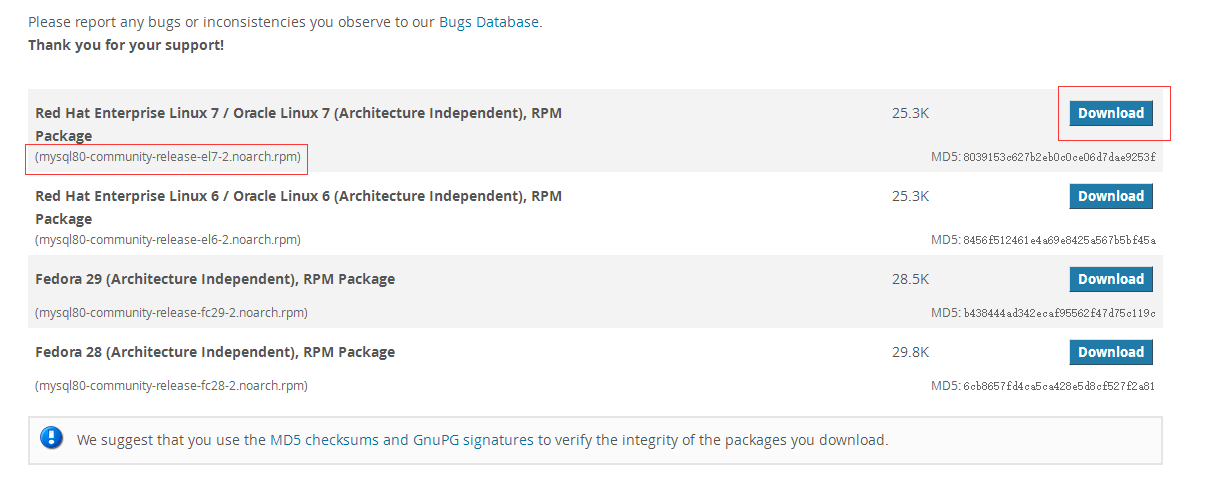
点击下载https://repo.mysql.com//mysql80-community-release-el7-2.noarch.rpm

yum localinstall mysql80-community-release-el7-2.noarch.rpm
yum install mysql-server
grep "password" /var/log/mysqld.log
2019-04-06T03:01:26.413527Z 5 [Note] [MY-010454] [Server] A temporary password is generated for root@localhost: l*acIwc&s5.8
systemctl start mysqld.service
mysql -u root -p;
l*acIwc&s5.8
ALTER USER USER() IDENTIFIED BY 'pAss#w0rd';
exit;
mysql -u root -p;
pAss#w0rd
exit;
# For advice on how to change settings please see
# http://dev.mysql.com/doc/refman/8.0/en/server-configuration-defaults.html
[mysqld]
skip-grant-tables
character_set_server=utf8
#
# Remove leading # and set to the amount of RAM for the most important data
# cache in MySQL. Start at 70% of total RAM for dedicated server, else 10%.
# innodb_buffer_pool_size = 128M
#
# Remove the leading "# " to disable binary logging
# Binary logging captures changes between backups and is enabled by
# default. It's default setting is log_bin=binlog
# disable_log_bin
#
# Remove leading # to set options mainly useful for reporting servers.
# The server defaults are faster for transactions and fast SELECTs.
# Adjust sizes as needed, experiment to find the optimal values.
# join_buffer_size = 128M
# sort_buffer_size = 2M
# read_rnd_buffer_size = 2M
#
# Remove leading # to revert to previous value for default_authentication_plugin,
# this will increase compatibility with older clients. For background, see:
# https://dev.mysql.com/doc/refman/8.0/en/server-system-variables.html#sysvar_default_authentication_plugin
# default-authentication-plugin=mysql_native_password
datadir=/var/lib/mysql
socket=/var/lib/mysql/mysql.sock
[mysqld_safe]
log-error=/var/log/mysqld.log
pid-file=/var/run/mysqld/mysqld.pid
systemctl restart mysqld.service
ps -A|grep mysql
14384 ? 00:00:08 mysqld
mysql -u root -p
use mysql;
create user 'hbs'@'localhost' identified by 'pAss#w0rd';
// 赋予hbs用户所有权限
// grant 权限 on 数据库.* to 用户名@登录主机 identified by "密码";
grant all privileges on *.* to hbs@localhost identified by 'pAss#w0rd';
// 刷新系统权限表
flush privileges;
// 查看用户权限
show grants for hbs@localhost;
exit;
mysql -u hbs -p
pAss#w0rd
ALTER USER 'hbs'@'localhost' IDENTIFIED WITH mysql_native_password BY 'pAss#w0rd';
show variables like 'char%';
exit;
systemctl stop mysqld.service
# For advice on how to change settings please see
# http://dev.mysql.com/doc/refman/8.0/en/server-configuration-defaults.html
[client]
port = 3306
default-character-set = utf8mb4
[mysql]
default-character-set = utf8mb4
[mysqld]
#skip-grant-tables
#character_set_server=utf8
port = 3306
character-set-client-handshake = FALSE
character-set-server = utf8mb4
collation-server = utf8mb4_0900_ai_ci
init_connect='SET NAMES utf8mb4'
skip-character-set-client-handshake = true
#
# Remove leading # and set to the amount of RAM for the most important data
# cache in MySQL. Start at 70% of total RAM for dedicated server, else 10%.
# innodb_buffer_pool_size = 128M
#
# Remove the leading "# " to disable binary logging
# Binary logging captures changes between backups and is enabled by
# default. It's default setting is log_bin=binlog
# disable_log_bin
#
# Remove leading # to set options mainly useful for reporting servers.
# The server defaults are faster for transactions and fast SELECTs.
# Adjust sizes as needed, experiment to find the optimal values.
# join_buffer_size = 128M
# sort_buffer_size = 2M
# read_rnd_buffer_size = 2M
#
# Remove leading # to revert to previous value for default_authentication_plugin,
# this will increase compatibility with older clients. For background, see:
# https://dev.mysql.com/doc/refman/8.0/en/server-system-variables.html#sysvar_default_authentication_plugin
# default-authentication-plugin=mysql_native_password
systemctl start mysqld.service
ps -A|grep mysql
mysql -u root -p
pAss#w0rd
show variables like 'char%';
输出结果为:(数据库默认编码为拉丁文)
mysql> show variables like 'char%';
+--------------------------+--------------------------------+
| Variable_name | Value |
+--------------------------+--------------------------------+
| character_set_client | utf8mb4 |
| character_set_connection | utf8mb4 |
| character_set_database | utf8mb4 |
| character_set_filesystem | binary |
| character_set_results | utf8mb4 |
| character_set_server | utf8mb4 |
| character_set_system | utf8 |
| character_sets_dir | /usr/share/mysql-8.0/charsets/ |
+--------------------------+--------------------------------+
8 rows in set (0.01 sec)
exit;
systemctl restart mysqld.service
netstat -ln | grep 3306
tcp6 0 0 :::3306 :::* LISTEN
tcp6 0 0 :::33060 :::* LISTEN
至此,数据库已经安装并配置完毕!

create database db_niudan;
use db_niudan;
source db_niudan.sql;
show tables;
select*from merchant;
至此,数据库已迁移完毕!
4/6/2019 11:33:37 PM 已解决!